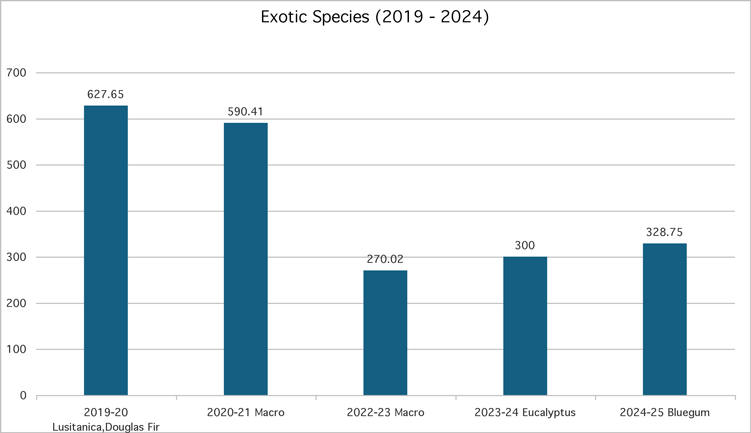Purpose
The purpose of this document is to act as a guideline in monitoring and managing common and known pests in the forest estate.
Background
There are a number of pests present or potentially present in the Longwood and Rowallan Forest Estate. Those include both plant and animal pests as listed in the L&D Pest Monitoring Procedures.
L&D have developed specific pest strategies for
* Stoats/Ferrets
* Possums
* Deer and pigs
* Wilding exotic tree species
Rationale:
Animal pests in localized operational areas will be monitored by the L&D bush crew. Deer & pigs are popular hunting species and are actively controlled by staff, local hunters and contractors.
Stoats and possums will predominantly be managed by local contractors in conjunction with L&D Management, by developing periodic trapping programs and monitoring and recording kill numbers.
The purpose of the animal pest management strategy is to identify the extent of population numbers on a localized basis; consider the potential impacts; and if necessary develop and undertake more intensive control program.
Plant Pests
Wilding exotic tree species are present in small areas throughout the forest estate, Initial identification and mapping of known areas indicates approximately 83 hectares from an estate of 11916 hectares.
The wilding tree stock is predominantly Eucalyptus Species and is currently certified under our FSC program NC-FM/COC-001148.
These areas were planted by the New Zealand Forest Services in the 1960's on skid sides, road line areas and as trial plots of alternative species.
L&D carried out a harvest program in 2008/2009 to remove the wilding trees (predominantly Eucalyptus species) and have continued to harvest and remove minor areas of wildings as located during day to day operations.
The known areas of wilding trees are self contained and there is no evidence of spread or expansion into the natural forest estate.
The company will manage the wilding areas by:
* Harvesting and removing wilding trees as located during day to day activities.
* Monitoring the previously harvested areas to ensure containment of the wildings remains within the original areas
PEST MANAGEMENT ELEMENTS
|
Stoat/Ferret
|
Initial Specification Date
|
15th February 2018
|
|
Objective(s)
|
1. To determine whether there is a significant stoat population in the forest.
2. If so, to implement controls and reduce numbers.
|
|
Current Scope
|
To gauge the level of stoat/ferret populations in and near operational areas.
|
|
Location
|
Operational forest area.
|
|
Method
|
Trapping using tunnel traps or Good Nature traps.
|
|
Rationale
|
Experimental.
|
|
Personnel
|
L&D staff or appointed contractors.
|
|
Commencement
|
At commencement and during new forest operations.
|
|
Frequency
|
Casual by staff. Periodically by negotiation with Contractors.
|
|
Monitoring
|
Location of traps GPS mapped and kills recorded
|
|
Reporting
|
Results summarised annually (FYE) and reported in website monitoring conditions
|
|
Wilding Species
|
Initial Specification Date
|
15th February 2018
|
|
Objective(s)
|
1. To identify wilding exotic trees species.
2. To progressively remove those exotic wildings.
|
|
Current Scope
|
To identify, fell and remove exotic wilding trees from known locations and operational areas.
|
|
Location
|
Throughout Longwood & Rowallan Forest Estate.
|
|
Management Method
|
Identify, fell and extract.
|
|
Rationale
|
Removal of wilding species.
|
|
Personnel
|
L&D Bushcrew and appointed contractors.
|
|
Equipment / Requirements
|
Conventional ground-based extraction & transport.
|
|
Commencement
|
May 2007 & on-going.
|
|
Frequency
|
As identified across the forest estate.
|
|
Monitoring
|
Monitor wilding regeneration and containment.
|
|
Reporting
|
Annual (FYE) summary of volumes removed
|
|
Possum
|
Initial Specification Date
|
15th February 2018
|
|
Objective(s)
|
1. To determine whether there is a significant possum population in the forest.
2. If so, to implement controls and reduce numbers.
|
|
Current Scope
|
To gauge the level of possum populations in and near operational areas.
|
|
Location
|
Operational forest area by L&D. Other forest blocks by contractors.
|
|
Method
|
Trapping or shooting. Location of traps mapped and results recorded.
|
|
Rationale
|
Experimental.
|
|
Personnel
|
L&D staff and appointed contractors.
|
|
Commencement
|
At commencement and during new forest operations.
|
|
Frequency
|
Casual by staff and periodically by negotiation with contractors.
|
|
Monitoring
|
Location of traps GPS mapped and kills recorded.
|
|
Reporting
|
Results summarised annually (FYE) and reported in website monitoring conditions.
|
|
|
|
Deer and Pig
|
Initial Specification Date
|
15th February 2018
|
|
Objective(s)
|
1. To determine whether there is a significant possum population in the forest.
2. If so, to implement controls and reduce numbers.
|
|
Current Scope
|
To gauge the level of deer and pig populations in and near operational areas. Hunting permit and monitoring in other forest ares.
|
|
Location
|
Operational forest are by L&D. Hunting permits and monitoring of other forest areas by public and contractors.
|
|
Method
|
Hunting
|
|
Rationale
|
To monitor and encourage local hunting via the use of the permit system
|
|
Personnel
|
L&D staff / local hunters, clubs and contractors
|
|
Equipment/Requirements
|
N/A
|
|
Commencement
|
At commencement and during new forest operations and by monitoring previously harvested areas
|
|
Frequency
|
Casual and ongoing
|
|
Monitoring
|
Via permit system and community / club contact
|
|
Reporting
|
Results summarised annually (FYE) and reported in website monitoring conditions.
|

|